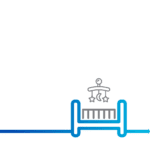Childcare costs widening gender pensions gap warns The People’s Pension, as almost four in 10 women would choose to work more if childcare was cheaper
The People’s Pension1, a leading not-for-profit pension provider, has warned that childcare costs are widening the gender pensions gap, as new research finds that almost four in 10 women (38 per cent) working part-time would choose to increase their hours if childcare was cheaper2.
The gender pensions gap is currently more than double the size of the total gender pay gap with the average female pensioner £7,000 a year poorer than her male equivalent.3
In a new report, ‘The Gender Pensions Gap; Tackling the Motherhood Penalty’, The People’s Pension highlights that while changes to auto-enrolment pensions are needed to ensure lower earners or part-time workers – the majority women – aren’t penalised by the current policy, an inescapable root cause of the gender pensions gap is the ‘Motherhood Penalty’ women pay when their children are born.
The People’s Pension’s survey of 2,000 mothers across the UK, carried out by You Gov, found that after having children, nearly half of women (44%) reduced their hours, more than a third (36%) left work altogether and more than one in five (15%) returned to work in a lower grade or lower paid role.4
These changes in their working lives have a significant impact on their ability to save for a pension at the same level as men; women are likely are likely to stop or significantly reduce their pension contributions, meaning they may miss out on employer contributions and lose the investment gains their contributions would earn.
While many women choose to reduce their hours or stop working because they want to spend more time with their children, the survey found that:
- Of those that left the workforce altogether, more than four in 10 (43 per cent) said it didn’t make financial sense to keep working and pay childcare, while three in 10 (29 per cent) said they couldn’t afford suitable childcare5
- Of those that reduced their hours or role after having a child or children, more than a third (36%) said it made more financial sense to work part-time than pay for childcare, while almost a quarter (23%) couldn’t afford suitable childcare6
- Almost four in 10 women (38%) who returned to work on reduced hours after having a child would have increased their hours if childcare was more affordable2
Sam, 32, from Northamptonshire has three children under the age of eight and gave up work when her eldest was born.
“I gave up my job working in a supermarket as the cost of childcare would have been far more than my wages. I haven’t worked since my son was born – with my husband the sole earner – as we were better off with me at home. I’m at a point now, with two of my kids in school, where I want to go back to work but finding something that makes sense financially, with hours that work for us, is really difficult.”
Childcare in the UK is more expensive than anywhere else in Europe7. Analysis by The People’s Pension suggests that a woman in London with a child under two, who earns the median full-time income, will pay three-fifths of their after-tax earnings (60 per cent) on childcare, commuting and associated expenses, reducing take home pay to £9,700 per year or a little over £800 per calendar month. Outside of London the numbers aren’t much better with a woman on the median full-time salary paying 44 per cent of after-tax income in childcare costs, leaving her with around £13,000 a year to live on. 8
Commenting, Gregg McClymont, director of policy at The People’s Pension and former shadow pensions minister, said:
“The gender pensions gap is stark. By the time the average woman reaches retirement, the size of her pension pot will only be a fifth of that of a man her age. Women are getting short-changed on pensions for several reasons – not least because of the caring responsibilities they tend to take on across their lifetime.
“To look after their children, women often reduce their working hours or stop working altogether and their rates of pay and potential for progression can be unfairly affected, all of which mean their potential pension savings take a hit.
“Of course, many women choose to reduce their working hours or leave their job because they want to spend more time with their kids, but our research is clear – the cost and availability of childcare is a key factor for many women. If we’re going to tackle pensions inequality, not only are changes to auto-enrolment required but better provision of affordable childcare is a must to enable those mums that want to keep working or work more hours, to be able to.”
To help reduce the gender pensions gap, The People’s Pension is urging the government to consider measures to improve childcare provision across the UK and ensure women aren’t penalised by current pension policy.
These measures include:
- A single, specific ear-marked grant to local authorities to cover the real cost of the guaranteed 30-hours per week childcare for all 3- and 4-year olds
- Cutting the required earnings to be eligible for an auto-enrolment pension to the primary National Insurance threshold to bring in half a million new pension savers – three-quarters of whom would be women
- Bring quality childcare back to UK high streets by offering imaginative schemes to providers willing to fit out vacant shops and by making private nurseries exempt from business rates
- Abolishing the net-pay tax quirk to ensure 1.75m low earners, the majority women, receive much-needed tax relief through auto-enrolment that they currently miss out on
- increasing the maximum amount of childcare costs paid for under Universal Credit to ensure parents are better off for every extra hour worked and switch to upfront payments for childcare so that parents can afford to begin work
- extending the existing system of state pension carers credits to auto-enrolment reducing the pensions gender gap in auto-enrolment savings
For Keziah, 37, from Leicestershire, if it wasn’t for family support, she wouldn’t have been able to continue working after the birth of her daughter as childcare cost more than she earned.
“As a single mum and the sole earner in our house I had to keep working full-time in order to pay our bills. Thankfully childcare wasn’t a cost I had to juggle as my mum looked after my daughter while I was at work. I’d already had to move to a different job and take a pay cut to allow me to balance parenting and work, and without mum I would have had to give up my job altogether as nursery fees cost more than I earned at the time.”
ENDS
- The People’s Pension is a leading, not-for-profit, auto-enrolment pension provider, with more than 4 million members from 85,000 employers and more than £6bn assets under management (accurate at 13 May 2019). We tweet as @peoplespension.
- In England, 38% who returned to work on reduced hours after having a child would have increased their hours if childcare was more affordable. In Wales it was 42% and in Scotland 36%. The full regional breakdown is attached.
- Tackling the gender pension gap, Prospect, Nov 2018
- After having children, 44% of women in England reduced their hours, 37% left work altogether and 15% returned to work in a lower grade or lower paid role. In wales, 35% of women reduced their hours, 45% left work altogether and 13% returned to work in a lower grade or lower paid role. In Scotland, 49% of women reduced their hours, 29% left work altogether and 16% returned to work in a lower grade or lower paid role. The full regional breakdown is attached.
- In England, of those that left the workforce altogether, 43% said it didn’t make financial sense to keep working and pay childcare, while 30% said they couldn’t afford suitable childcare. In Wales, 50% said it didn’t make financial sense to keep working and pay childcare and 33% said they couldn’t afford childcare. In Scotland, 43% said it didn’t make financial sense to keep working and pay for childcare while 22% said they couldn’t afford childcare. Full regional breakdown attached.
- In England, of those women that reduced their hours or grade after having a child or children, 36% said it made more financial sense to work part-time than pay for childcare, while 22% couldn’t afford suitable childcare. In Wales, 36% of women said it made more financial sense to work part-time than pay for childcare and 24% said they couldn’t afford childcare. In Scotland, 37% of women said it made more financial sense to work part-time and 26% said they couldn’t afford childcare. Full regional breakdown attached.
- https://peoplespartnership.co.uk/downloads/european-semester-thematic-factsheet-labour-force-participation-women-en/
London median salary £37,086.40 (Source: ONS)
London median salary after tax £28,600 (Source: Reed)
London weekly 50 hrs per week childcare cost for under 3 £330 (Source: Money Advice Service)
London commuting/lunch costs £10 per day (Source: The People’s Pension’s calculation)National median salary £29,600 (Source: ONS)
National median salary after-tax £23,500 (Source: Reed) National weekly 50 hrs per week childcare cost for under 3 £232.84 (Source: Reed)
Note: A 50-hour week is likely for a child of two working parents; a mother working a full eight-hour day would likely need an additional hour at each end of the day for commuting time
Link to ONS data
Link to Reed Calculator
Link to Coram Childcare Trust Cost Survey (See P 8)







